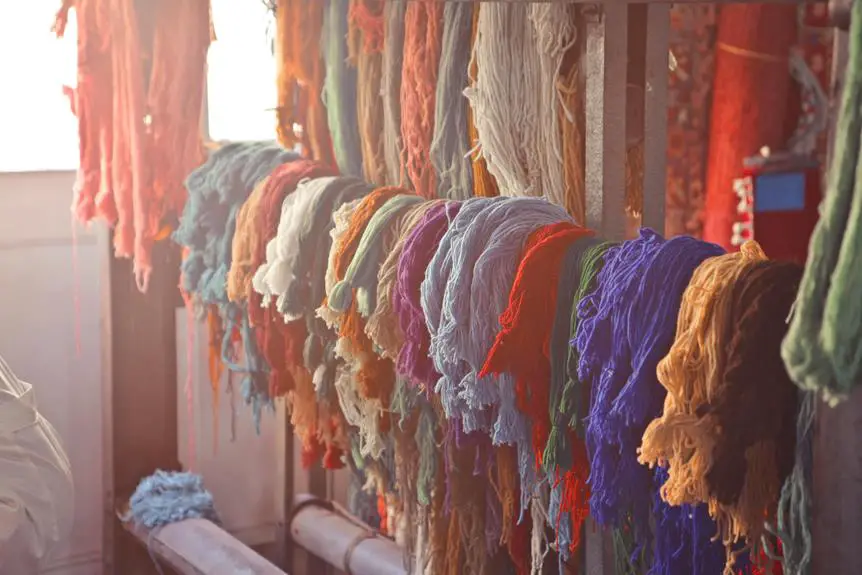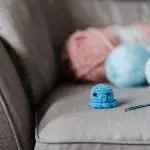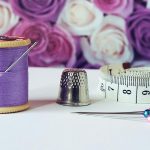When you're tackling embroidery projects, understanding how to stiffen your fabric can significantly impact your results. You might find that the right stiffening technique not only enhances the clarity of your designs but also prevents common issues like puckering and distortion. From using spray starch to fabric stabilizers, each method has its place depending on your fabric type and design complexity. But what happens when you choose the wrong approach? The answer could change how you approach your next project entirely.
Table of Contents
Key Takeaways
- Choose the appropriate stiffening agent, such as fabric stiffener, starch, or interfacing, based on fabric type and desired stiffness.
- Apply spray starch evenly from a distance, then use an iron to set the stiffness for crisp results.
- Select the right stabilizer type (tear-away, cut-away, or wash-away) to maintain fabric integrity during embroidery.
- Pre-wash fabric to remove chemicals, and ensure stabilizer is taut under the fabric during hooping for best results.
Importance of Stiffening Fabric
Stiffening fabric is crucial for achieving crisp, clean embroidery designs that stand out and maintain their shape over time. When you're working on an embroidery project, you want your designs to pop, and stiffening helps you achieve that professional look. It provides the necessary support to the fabric, ensuring that your stitches lay flat and stay in place without puckering or distortion.
Using stiffened fabric makes it easier to handle during the embroidery process. You'll find that it's less likely to shift or bunch up under the needle, allowing for more precise stitching and fewer mistakes. Plus, once your project is complete, stiffening helps your fabric hold its shape, so it looks great whether it's a decorative piece or clothing.
Another benefit is that stiffened fabric can enhance the overall durability of your embroidery. It can withstand wear and washing better than un-stiffened fabric, ensuring that your designs remain vibrant and intact over time.
In short, stiffening fabric is an essential step in achieving high-quality embroidery that lasts, making it a must for any serious embroiderer.
Types of Stiffening Agents
When you're choosing a stiffening agent for your embroidery projects, you'll find several options that can help achieve the desired firmness and support.
One popular choice is fabric stiffener, which comes in both liquid and spray forms. Liquid stiffeners work well for soaking your fabric before drying, while sprays allow for quick application on the surface.
Another option is starch, which can provide varying levels of stiffness based on how much you use. You can mix it with water for a custom solution, adjusting the concentration according to your needs.
If you prefer something more natural, consider using a solution of white glue diluted with water. This method adheres well and offers a solid finish.
For projects requiring a more long-lasting solution, you might want to explore interfacing. Fusible interfacing can be ironed onto your fabric, providing structure and support without altering the fabric's texture significantly.
Finally, you can also use commercial products like fabric sizing, designed specifically for stiffening fabric and providing a clean finish.
Each type of stiffening agent has its unique benefits, so choose one that fits your project requirements best.
Spray Starch Techniques
Using spray starch effectively can enhance your embroidery projects by providing just the right amount of stiffness without weighing down the fabric. To get started, choose a good-quality spray starch and shake the can well.
Lay your fabric flat on a clean surface, ensuring it's wrinkle-free. Hold the can about 6 to 12 inches away and spray evenly across the fabric. Be careful not to oversaturate; a light mist is all you need.
After applying the starch, use an iron set to the appropriate temperature for your fabric type. Press the fabric gently, moving the iron in one direction to avoid distortion. This will help set the starch and maintain the stiffness you desire.
Once the fabric cools, it's ready for your embroidery design. If you find that the stiffness isn't quite right, don't hesitate to repeat the process. You can always add more starch for extra crispness. Just remember to test on a scrap piece first to ensure the desired effect.
Using Fabric Stabilizers
Fabric stabilizers play a crucial role in ensuring your embroidery projects maintain their shape and integrity throughout the stitching process. Choosing the right stabilizer can make all the difference in achieving professional-looking results. Here are four key types of fabric stabilizers you should consider:
- Tear-Away Stabilizer: Ideal for most woven fabrics, this stabilizer tears away easily after stitching, leaving your design clean and crisp.
- Cut-Away Stabilizer: Best for knits and stretchy fabrics, this stabilizer remains in place after embroidery, providing ongoing support and preventing distortion.
- Wash-Away Stabilizer: Perfect for delicate fabrics and intricate designs, this stabilizer dissolves in water, allowing you to achieve a clean finish without any residue.
- Iron-On Stabilizer: This type adheres to the fabric with heat, providing stability while you stitch. It's great for preventing shifting during the embroidery process.
Gelatin and Water Method
The gelatin and water method is an effective way to stiffen fabric for embroidery, providing a temporary solution that helps maintain your design's structure during stitching. This method is simple and inexpensive, making it accessible for everyone. To get started, you'll need unflavored gelatin, water, and a bowl.
Here's a quick overview of the process:
| Step | Description |
|---|---|
| Mix the Gelatin | Combine 1 tablespoon of gelatin with 1 cup of warm water until dissolved. |
| Soak the Fabric | Immerse your fabric in the gelatin mixture, ensuring it's fully saturated. |
| Dry and Iron | Lay the fabric flat to dry, then iron it on a low setting for a crisp finish. |
After drying, your fabric will hold its shape, making it easier to work on your embroidery. Remember, this stiffening effect is temporary, so you'll want to use it when you need extra support during your project. Plus, it rinses out easily when you're done. Enjoy the benefits of this method as you create beautiful embroidery designs!
Commercial Stiffening Products
Explore various commercial stiffening products that can provide a permanent solution for your embroidery projects. These products are designed to help you achieve the desired firmness and longevity for your fabric, ensuring your designs look their best.
- Fabric Stiffener Spray: This convenient option allows you to spray directly onto your fabric, providing a quick and easy stiffening solution. It dries clear and maintains flexibility, which is perfect for delicate projects.
- Liquid Starch: A classic choice, liquid starch can be mixed with water for a customizable stiffness level. It's great for larger pieces and can be easily washed out if needed.
- Heavy-Duty Fabric Stiffener: If you need a more robust solution, consider heavy-duty fabric stiffeners. These are ideal for projects requiring extra support, like home decor and crafts.
- PVA Glue: Polyvinyl acetate (PVA) glue can be diluted with water and used to stiffen fabric. It dries clear and provides a strong hold, making it suitable for a variety of applications.
Tips for Best Results
To achieve the best results when stiffening your fabric for embroidery, it's crucial to choose the right stabilizer for your project.
You'll also want to use effective application techniques to ensure everything holds up during the stitching process.
Let's explore these key points to make your embroidery shine.
Choosing the Right Stabilizer
Choosing the right stabilizer can make all the difference in achieving crisp, professional-looking embroidery results. The stabilizer you select should complement your fabric and the type of embroidery you're doing. Here are some tips to help you choose wisely:
- Fabric Type: Consider the fabric's weight and texture. Lightweight fabrics typically need a tear-away or wash-away stabilizer, while heavier fabrics may require a cut-away stabilizer for better support.
- Embroidery Design: Intricate designs with dense stitching benefit from a more robust stabilizer. For lighter designs, a lighter stabilizer will suffice.
- Stabilizer Type: Familiarize yourself with the different stabilizer types—tear-away, cut-away, wash-away, and fusible. Each serves a unique purpose and can dramatically affect your final result.
- Test First: Always do a test stitch on a scrap piece of fabric before starting your main project. This lets you see how the stabilizer interacts with your fabric and design.
Application Techniques for Success
Once you've selected the right stabilizer, applying it correctly is key to achieving the best results for your embroidery project.
Start by pre-washing your fabric to remove any sizing or chemicals, which can interfere with the stabilizer's adhesion. Cut your stabilizer to fit the hoop and fabric, ensuring there's enough excess to catch any potential fraying.
When you're ready to hoop, place the stabilizer underneath the fabric, making sure it's taut but not stretched. If you're using adhesive stabilizer, spray it lightly on the fabric before placing it in the hoop to ensure a secure hold. For extra stability, consider using two layers of stabilizer, especially for heavier fabrics or intricate designs.
As you stitch, keep an eye on your tension. Adjust it if necessary to prevent puckering or distortion. After finishing, gently tear away the excess stabilizer, being careful not to damage your embroidery.
If you've used a water-soluble stabilizer, rinse it out according to the manufacturer's instructions. Lastly, press your finished piece with a low heat setting to smooth any wrinkles while preserving the design's integrity.
Frequently Asked Questions
Can I Stiffen Fabric Without Using Chemicals?
Yes, you can stiffen fabric without chemicals! Try using natural options like diluted cornstarch, sugar water, or a mixture of flour and water. Apply it to your fabric, then let it dry thoroughly for best results.
How Do I Store Leftover Stiffening Agents?
To store leftover stiffening agents, pour them into a clean, airtight container. Label it with the date and type. Keep it in a cool, dry place, avoiding direct sunlight to maintain its effectiveness.
What Fabrics Are Unsuitable for Stiffening?
Certain fabrics, like stretchy knits or delicate silks, don't hold up well with stiffening agents. You'll find they may warp or lose their natural drape, so it's best to avoid those materials for stiffening.
Can I Wash Stiffened Fabric After Embroidery?
You can wash stiffened fabric after embroidery, but be cautious. Hand washing is best to avoid damaging the stitches. Always check the stiffening product's instructions to ensure it can withstand water without losing its shape.
How Do I Remove Stiffness From Fabric Afterward?
You can remove stiffness by soaking the fabric in warm water with a mild detergent. Gently agitate it, then rinse thoroughly. Air dry to restore softness, ensuring you avoid harsh chemicals that could damage the material.
- How Does Ring Spun Cotton Affect Garment Fit and Shape Retention? - August 13, 2024
- What Are the Challenges in Producing Ring Spun Cotton? - August 13, 2024
- Is Ring Spun Cotton Suitable for Plus-Size Clothing? - August 13, 2024






